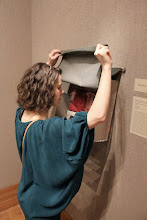I walked into the single gallery room, a wide-open space and wished for a party. Definitely Champagne in fluted glasses. Besides the fact that it was an opening and many art world celebrities were there, there was a festive feel in the air. The celebration tittered from the work, which is light and playful, but glamorous all the while. Klimnik toys with the adult sophistication of fashion.
The room was cheap glamour, like glamour in quotes, but it was elegant and absolutely convincing. A poor-man’s Chanel fashion show. A few hints here and there to conclude style. Kitch paintings, awkward, gawky teenage drawings, a installation of photocopies, including a boot filled with crumpled plastic and fake pearls, with tinny music playing. Also some dark, amateur photographs and Ikea-esque chandaliers and music coming out of tinny speakers helped to reiterate this theme. This doesn’t sound like the scene of glamour. Isn’t glamour expensive and rich and decadent, not sparse and cheap? She achieved elegance with a surface touch. She achieved depth while entertaining (and being entertained by) the surface.
Kilimnik created a place that felt magical, even if the viewer only catches glimpses and hints, they added up to a world that one can enter into. Fantasy plays a large part in modern society though it isn’t often referred to as such. Dreaming is not something to brag about, results and progress and action are. It is now even the trend for artists, the professional dreamers, to be workaholics. But I cheer the dreamers. I understand Marlene Dumas and Agnes Martin who prefer doing nothing to always doing something. Imagination is fed by dreaming. Just the word, dreeaaming, slow and drawn out makes me think of lying in long grass, in shorts, staring at the sky while chewing a blade. Cramming for an exam does not whisper imagination, but rather screams ambitious goals of a mega-monster artist.
The reason I am drawn to Kilimnik is much for the same reason I am drawn to Ree Morton and Laura Owens. There is an element of space in the work. The work is simple but energized with something exciting, something beyond the material work. What is that? Is art adult-life dreaming? Jonathan Meese also considers art-making one big play-pen and I find this attitude freeing. It is modest and reduces art making to something a child does, rather than an ego enhancing career-choice. It may sound sentimental to wax on about innocence and purity and playing and dreaming, but the hard shells we grow into as adults could use some of this.
For the most part I tend to think of glamour as a constructed cold hard shell. One I love but have to consciously learn. It is something used regularly in urban society to protect that playful innocent and vulnerable child. So, I applaud Kilimnik for combining these two things, the cold with the warm, the adult with the child and the jaded with the innocent.
